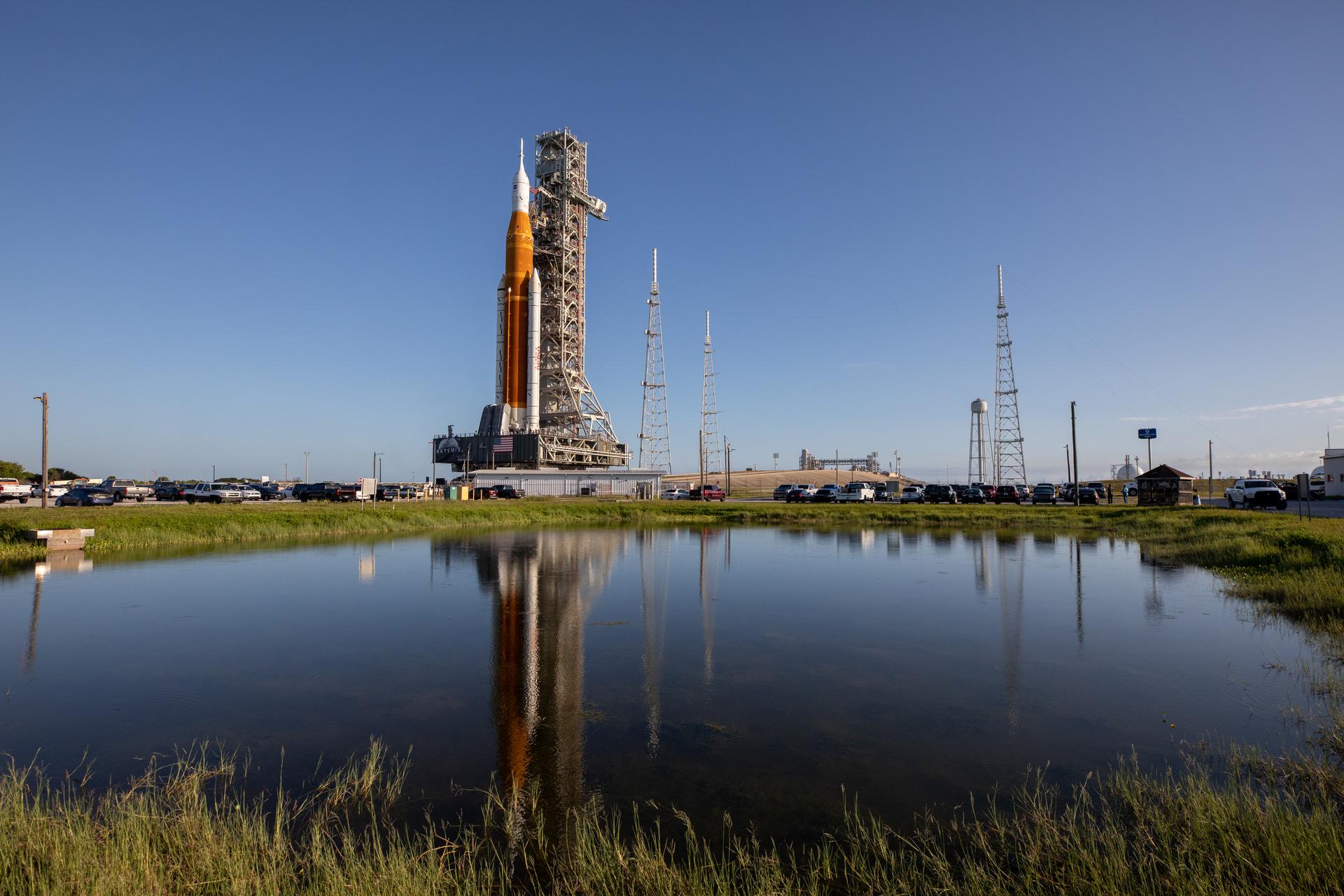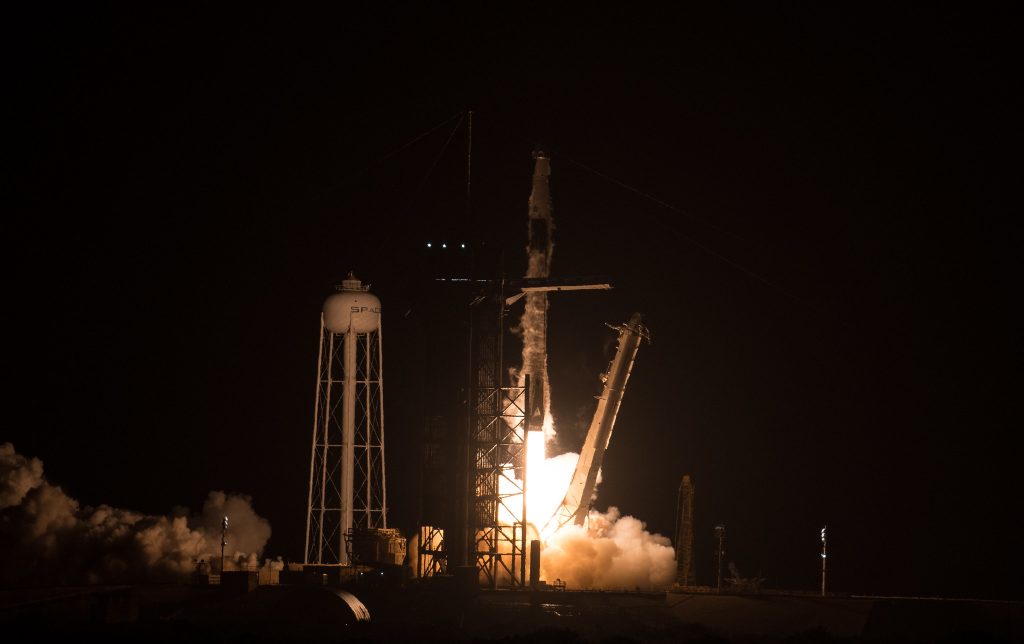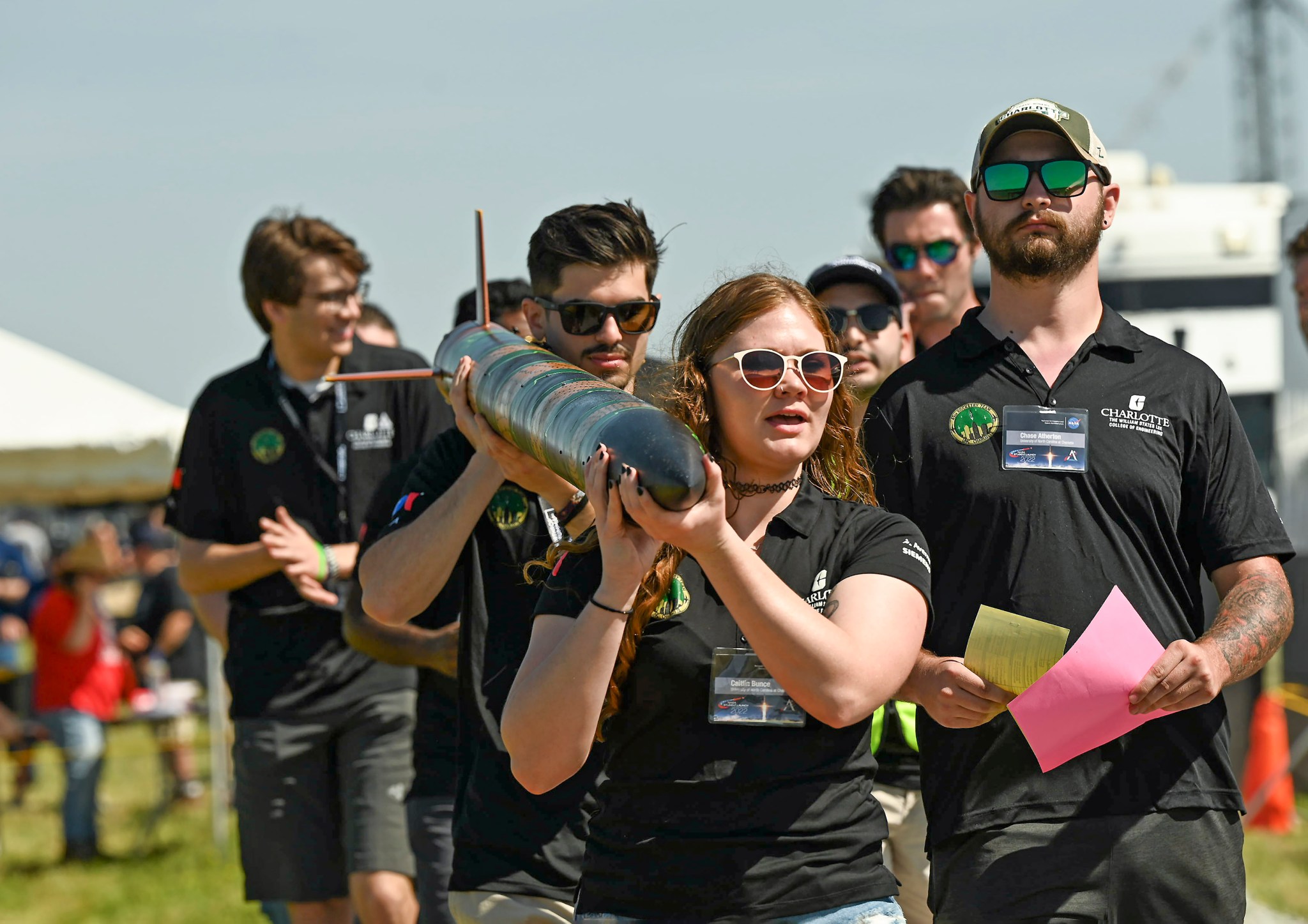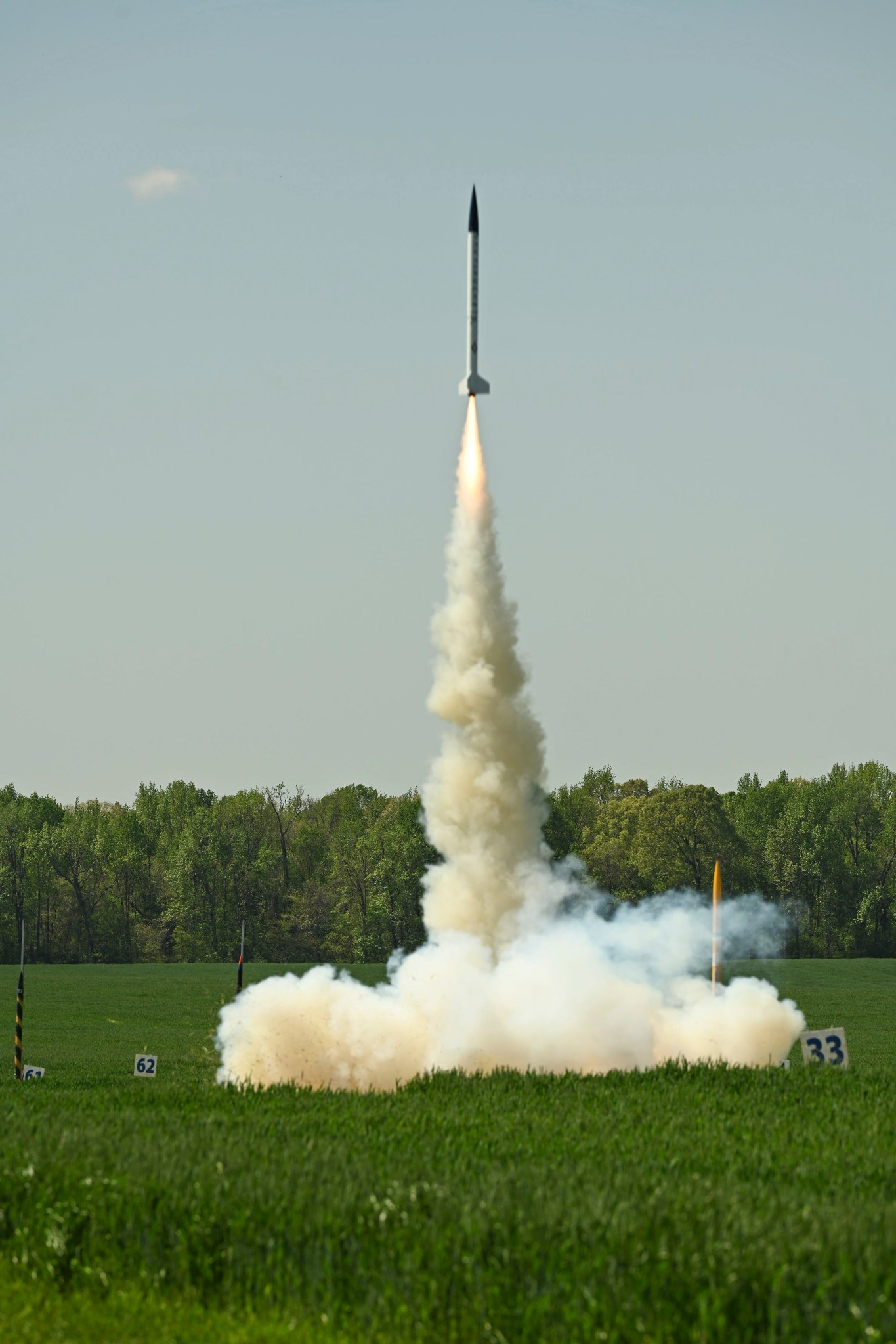In This Week’s Star
- NASA’s Artemis I Moon Rocket Arrives at Launch Pad Ahead of Tanking Test
- Subscale Booster Motor for Future Artemis Missions Fires Up at Marshall
- Marshall Engineer Crystal Klemmer Supports NASA’s Crew-4 Mission
- NASA Opens Second Phase of $3.5 Million Lunar Excavation Competition
- NASA Announces Winners of 2022 Student Launch Competition
- First Full-Color Images Coming Soon from Webb Space Telescope
NASA’s Artemis I Moon Rocket Arrives at Launch Pad Ahead of Tanking Test

NASA’s Artemis I Moon rocket – carried atop the crawler-transporter 2 – approaches Launch Pad 39B at the agency’s Kennedy Space Center on June 6. The rocket rolled out of the Vehicle Assembly Building in the early morning hours to travel 4.2 miles in eight hours to the launch pad for NASA’s next wet dress rehearsal attempt ahead of the Artemis I launch. Teams are working to secure the Space Launch System rocket, Orion spacecraft, and mobile launcher to ground support equipment at the launch pad and ensure that the rocket is in a safe configuration for the upcoming tanking test. Prior to rollout, teams successfully completed all major planned objectives identified during the previous wet dress rehearsal attempts, as well as some forward work previously planned for after the tanking test. (NASA/Ben Smegelsky)
Subscale Booster Motor for Future Artemis Missions Fires Up at Marshall
By Alyssa Lee
Engineers successfully fired a 2-foot-diameter, subscale solid rocket booster June 1 at NASA’s Marshall Space Flight Center. The test, conducted in Marshall’s East Test Area, produced 92,000 pounds of thrust and was done as part of the booster obsolescence and life extension (BOLE) program, providing an upgraded booster design for the evolved configuration of the Space Launch System (SLS) rocket for Artemis IX and beyond. The BOLE booster will be a larger and more powerful solid rocket motor to make the SLS rocket capable of sending heavier payloads to the Moon and beyond.
The test was the second in the series to evaluate the new motor design with an added half segment, a new propellant, a new aft dome design, and a new nozzle design. The first test was completed Dec. 2, 2021, and produced 76,400 pounds of thrust.
For this second test, lead booster contractor Northrop Grumman used a different propellant than in the first test to put the motor under the maximum expected operating pressure it could experience on launch day. Engineers will use data from the test to analyze how the motor performed under this pressure, which could be reached on a really hot day on the launch pad at NASA’s Kennedy Space Center.
A third subscale test of the new design, scheduled for next year, will evaluate alternate materials for both the nozzle and insulation for the motor. The subscale motor tests are an important step in learning how the BOLE motor will perform at full-scale. The team is working to complete the final design for a test of the full-scale motor in the spring of 2024 at Northrop Grumman’s test facility in Utah.
Lee, a Media Fusion employee, supports Marshall’s Office of Strategic Analysis & Communications.
Marshall Engineer Crystal Klemmer Supports NASA’s Crew-4 Mission
By Tee Quillin

When it comes to making sure that engines and boosters for NASA’s SpaceX human spaceflight missions are safe to launch, Crystal Klemmer is at the forefront.
Klemmer is an aerospace engineer with Aerodyne Industries, working on the Engineering Services and Sciences Capability Augmentation contract in the Engineering Directorate’s Engine Systems Branch at NASA’s Marshall Space Flight Center. She’s also part of the Commercial Crew Program’s support team at Marshall. This support team assists commercial crew mission launches, primarily through support of launch vehicles, and has a long working relationship with the agency’s commercial partner, SpaceX.
Serving as Marshall’s certification lead for the SpaceX Merlin engines, Klemmer and her team members played a vital role working with SpaceX to close out the flight certification of the engines used in the Falcon 9 rocket that launched the SpaceX Dragon spacecraft with the Crew-4 astronauts to the International Space Station on April 27.
Merlin engine certification has several facets, including review of all major engine components, hardware, process changes, and known risk areas to ensure the hardware meets qualification requirements and that critical risk mitigation strategies are understood and implemented.
“Each engine has its own maintenance review cycle that must be completed to certify the engine for flight,” Klemmer said. “To show that the Merlin engine is reusable for multiple flights, we put the engine through a qualification program multiple times, and then we look at the data.
“Throughout certification and reuse assessments, new engines and their parts may also be upgraded. Each new part swap has to go through its own set of qualifications, and we have to be on top of all of them.”
Crew-4 is the fourth rotation mission for Dragon. During their stay on the space station, which will last several months, the four Crew-4 astronauts will conduct new scientific research in areas such as materials science, health technologies, and plant science to prepare for human exploration beyond low-Earth orbit and benefit life on Earth.
“During launch, after the normal second stage engine shut off and a call was made that the spacecraft was on the right trajectory and heading at the right speed, I didn’t celebrate with the team immediately,” Klemmer said. “I was just relieved my job was done, and the engines performed as expected. A week later it started to sink in that we have plenty to celebrate, and I am so thankful to work on such a specialized, supportive team.”

“I couldn’t be prouder of this team’s hard work supporting the Crew-4 mission,” said Lisa McCollum, who leads the commercial crew support team at Marshall. “Our team members approached each challenge with focus and remained committed to ensuring a safe, successful flight for delivering Crew-4 to the space station.
“Crystal has done an amazing job of communicating across the board and coordinating details while handling extra responsibilities.”
Originally from Des Moines, Iowa, Klemmer earned her bachelor’s degree in aerospace engineering from Ohio State University in Columbus. She started her career with the Air Force Research Laboratory, conducting liquid rocket engine research, developing herself as an engineer, and earning her master’s degree in engineering from California State Polytechnic University, Pomona. She then moved to Huntsville to work on Redstone Arsenal as an engineer with the Army Oil Analysis Program, assisting to keep the Army’s equipment and vehicles running.
Finally, Klemmer joined NASA at Marshall as a contractor performing trade studies on concept engines, helping the agency to determine the most feasible technologies for investments. She went on to support what was then called the CisLunar Transit Habitat – now called Gateway – as a systems engineer before transitioning in her current role on the commercial crew support team.
NASA’s Commercial Crew Program was formed to facilitate the development of a U.S. commercial crew space transportation capability with the goal of achieving safe, reliable, and cost-effective access to and from the space station and low-Earth orbit. The program is based at NASA’s Kennedy Space Center, with work also performed at other NASA centers, including Johnson Space Center and Marshall.
Quillin, a Media Fusion employee, supports Marshall’s Office of Strategic Analysis & Communications.
NASA Opens Second Phase of $3.5 Million Lunar Excavation Competition
By Taylor Goodwin
NASA launched the second phase of its Break the Ice Lunar Challenge to advance technology that is – quite literally – groundbreaking. The challenge invites the public to advance system technology for excavating and delivering lunar resources.
High on NASA’s list of innovation priorities are technologies that use the Moon’s resources to support sustainable surface operations while decreasing supply needs from Earth. This includes systems that could convert lunar ice into rocket fuel, drinkable water, or other vital resources.
“As NASA works to extend human exploration of the solar system, our first stop is a sustained presence on the Moon,” said Jim Reuter, associate administrator for NASA’s Space Technology Mission Directorate at NASA Headquarters. “New technologies and systems like these are essential for us to set a new paradigm for exploration.”
Phase 1 of the Break the Ice Lunar Challenge launched in 2020, seeking to incentivize innovative approaches for excavating icy regolith – or Moon dirt – and delivering acquired resources in extreme lunar environmental conditions.
NASA has identified several technology gaps related to harvesting and moving large quantities of resources on the Moon, including hardware capable of operating in the extreme cold and permanent to near-permanent darkness. Robotic systems for excavation will need to withstand the harsh environments inside permanently shadowed regions at the lunar South Pole, the targeted landing site for crewed Artemis missions where ice has been observed.
In Phase 2 of the challenge, teams will be asked to design, build, and test an icy regolith excavation system prototype and an icy regolith transportation system prototype to maximize resource delivery while minimizing energy use and the mass of equipment delivered to the lunar surface. Phase 2 contains three levels, will last for 23 months, and offers a total prize purse of $3 million.
In level one, teams will develop detailed engineering designs and long-duration demonstration test plans for their prototype systems. Eligible U.S. teams that meet submission requirements for level one will be awarded an equal share of the $500,000 prize purse. All teams that meet the submission requirements for level one will advance to level two.
In level two, teams will build terrestrial analog full-scale prototypes and conduct durability demonstrations. The top-scoring U.S. team will receive $300,000; the second-highest scoring U.S. team will receive $200,000; the third-highest scoring U.S. team will receive $125,000; and up to five U.S. runners-up will receive $75,000 each. Up to 15 teams – including winners and runners-up – that exceed the minimum score will advance to level three.
In level three, teams will test the prototype systems built in level two. The top-scoring U.S. team will receive $1 million, and the second-highest scoring U.S. team will receive $500,000. In addition to cash prizes, NASA will also award opportunities to test concepts in a thermal vacuum that will simulate the temperature and atmospheric pressure conditions at the dusty lunar South Pole.
Up to three top-scoring international teams will be recognized as winners in level two and level three. International teams are not eligible to be awarded prize money or thermal vacuum testing opportunities.
In 2021, NASA awarded 13 teams a share of a $500,000 prize purse for their Phase 1 designs of system architecture for collecting and moving large amounts of icy regolith and water from a permanently shadowed region near the Moon’s South Pole. Teams had seven months to register and submit a detailed system architecture, an excavation plan, and an animation of the system in operation. Thirty-one teams – including academia, industry, and independent inventors from 17 U.S. states, Canada, Australia, and Sri Lanka – submitted eligible proposals.
Phase 1 teams, as well as new competitors, are encouraged to register for Phase 2 on the challenge site by 11:59 p.m. EDT on Sept. 30, 2022.
The Break the Ice Lunar Challenge is a NASA Centennial Challenge, managed by NASA’s Marshall Space Flight Center and NASA’s Kennedy Space Center. Centennial Challenges are part of the Prizes, Challenges, and Crowdsourcing program within NASA’s Space Technology Mission Directorate. NASA has contracted Ensemble Consultancy to support the management of competitors for this challenge.
Goodwin, an LSINC employee, supports Marshall’s Office of Strategic Analysis & Communications.
NASA Announces Winners of 2022 Student Launch Competition
By Daniel Boyette
For the second year in a row, the University of North Carolina at Charlotte won the launch division, while Tarleton State University in Stephenville, Texas, won first place in the design division of NASA’s 2022 Student Launch rocketry competition. NASA announced the winners June 2 during a live virtual ceremony.
Each year, NASA challenges middle school, high school, college, and university students from across the United States to design, build and launch a high-powered amateur rocket, fly it to an altitude between 4,000 and 6,000 feet, and make a successful landing.
“Programs like NASA’s Student Launch are part of a greater process to prepare a new generation of scientists, engineers, astronauts, and explorers to pick up the torch and carry out the next missions. These students are the next generation – the Artemis Generation,” NASA Deputy Administrator Pam Melroy told the teams. “There are so many opportunities before them, and they should be so proud of what they’ve accomplished and learned in Student Launch. I encourage all of our participants to maintain a curiosity to learn and to explore.”
Sixty teams from 22 states including Puerto Rico took part in this year’s competition, with 27 teams launching April 23 near NASA’s Marshall Space Flight Center. Teams that did not travel were allowed to conduct their final test flights at a home launch field.
“We were thrilled both for the teams that were able to join us for the first Huntsville launch since 2019 and those that launched from a home field,” said Fred Kepner, an education program specialist and activity lead for Student Launch at Marshall. “The teams’ ability to adjust and conduct flights from the location that best suited their situation was another sign of their innovative spirit and drive to succeed.”
Teams in the college/university division tackled a new task that mirrors NASA’s missions like the Mars Curiosity Rover. Teams had to design a payload capable of autonomously locating where their rocket landed by identifying the rocket’s grid position on an aerial image of the launch site while transmitting the data back to their ground station. This had to be accomplished without the use of GPS. The requirement simulates a challenge faced by NASA’s mission managers – communicating with spacecraft and payloads on distant planetary bodies, where use of GPS is not an option. Middle and high school teams could choose to attempt the college/university division challenge or develop their own science or engineering experiment.
The University of North Carolina at Charlotte will receive $5,000 for first place in the launch division, and Tarleton State University will receive $2,500 for first place in the design division.
The top five teams in the launch division are:
- University of North Carolina at Charlotte
- University of Notre Dame, Notre Dame, Indiana
- Vanderbilt University, Nashville, Tennessee
- University of Florida, Gainesville
- Purdue University, West Lafayette, Indiana
The top two teams in the design division are:
- Tarleton State University, Stephenville, Texas
- New York University
Teams earned points for progress and successes during the nine-month competition, and the team with the most points won. Awards also were presented in multiple categories. For a complete list of winners, visit here.
For over 20 years, Student Launch has provided a realistic experience to students that resembles the development, test, and operational lifecycle NASA and industry engineers use when developing and operating new hardware. Marshall hosts Student Launch, and NASA’s Southeast Regional Office of STEM Engagement manages the event, which is one of the agency’s Artemis Student Challenges. These activities stimulate innovation and advance NASA’s human exploration mission through collaboration with educational institutions and students – the Artemis Generation, who will help NASA explore the Moon and Mars. NASA’s Space Operations Mission Directorate and Office of STEM Engagement, along with Northrop Grumman, provide funding and leadership for the initiative.
Boyette, an LSINC employee, supports Marshall’s Office of Strategic Analysis & Communications.
First Full-Color Images Coming Soon from Webb Space Telescope
An important target date for the James Webb Telescope is featured in “This Week @NASA,” a weekly video program broadcast on NASA Television and posted online.
The Webb team is planning to release the telescope’s first full-color images and spectroscopic data July 12. Some early test imagery has already demonstrated the unprecedented sharpness of Webb’s infrared view. But the images and data released next month will be the first to showcase Webb’s full science capabilities.
The Webb team at NASA’s Marshall Space Flight Center spent more than two decades working on Webb, primarily focusing on development and testing of the mirrors in extreme cold temperatures at which Webb operates.
View this and previous episodes at “This Week @NASA” on NASA’s YouTube page.



























